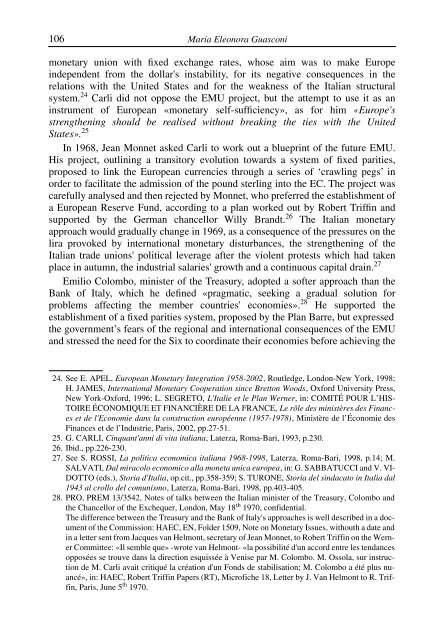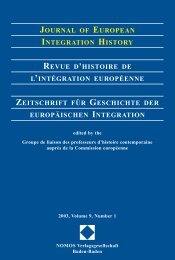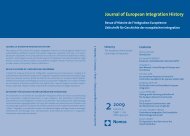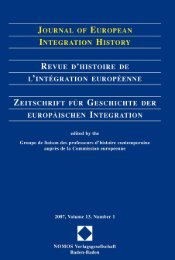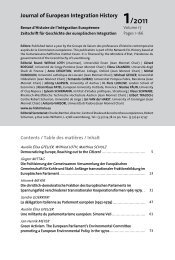journal of european integration history revue d'histoire de l ...
journal of european integration history revue d'histoire de l ...
journal of european integration history revue d'histoire de l ...
You also want an ePaper? Increase the reach of your titles
YUMPU automatically turns print PDFs into web optimized ePapers that Google loves.
106Maria Eleonora Guasconimonetary union with fixed exchange rates, whose aim was to make Europein<strong>de</strong>pen<strong>de</strong>nt from the dollar's instability, for its negative consequences in therelations with the United States and for the weakness <strong>of</strong> the Italian structuralsystem. 24 Carli did not oppose the EMU project, but the attempt to use it as aninstrument <strong>of</strong> European «monetary self-sufficiency», as for him «Europe'sstrengthening should be realised without breaking the ties with the UnitedStates». 25In 1968, Jean Monnet asked Carli to work out a blueprint <strong>of</strong> the future EMU.His project, outlining a transitory evolution towards a system <strong>of</strong> fixed parities,proposed to link the European currencies through a series <strong>of</strong> ‘crawling pegs’ inor<strong>de</strong>r to facilitate the admission <strong>of</strong> the pound sterling into the EC. The project wascarefully analysed and then rejected by Monnet, who preferred the establishment <strong>of</strong>a European Reserve Fund, according to a plan worked out by Robert Triffin andsupported by the German chancellor Willy Brandt. 26 The Italian monetaryapproach would gradually change in 1969, as a consequence <strong>of</strong> the pressures on thelira provoked by international monetary disturbances, the strengthening <strong>of</strong> theItalian tra<strong>de</strong> unions' political leverage after the violent protests which had takenplace in autumn, the industrial salaries' growth and a continuous capital drain. 27Emilio Colombo, minister <strong>of</strong> the Treasury, adopted a s<strong>of</strong>ter approach than theBank <strong>of</strong> Italy, which he <strong>de</strong>fined «pragmatic, seeking a gradual solution forproblems affecting the member countries' economies». 28 He supported theestablishment <strong>of</strong> a fixed parities system, proposed by the Plan Barre, but expressedthe government’s fears <strong>of</strong> the regional and international consequences <strong>of</strong> the EMUand stressed the need for the Six to coordinate their economies before achieving the24. See E. APEL, European Monetary Integration 1958-2002, Routledge, London-New York, 1998;H. JAMES, International Monetary Cooperation since Bretton Woods, Oxford University Press,New York-Oxford, 1996; L. SEGRETO, L'Italie et le Plan Werner, in: COMITÉ POUR L’HIS-TOIRE ÉCONOMIQUE ET FINANCIÈRE DE LA FRANCE, Le rôle <strong>de</strong>s ministères <strong>de</strong>s Financeset <strong>de</strong> l'Economie dans la construction européenne (1957-1978), Ministère <strong>de</strong> l’Économie <strong>de</strong>sFinances et <strong>de</strong> l’Industrie, Paris, 2002, pp.27-51.25. G. CARLI, Cinquant'anni di vita italiana, Laterza, Roma-Bari, 1993, p.230.26. Ibid., pp.226-230.27. See S. ROSSI, La politica economica italiana 1968-1998, Laterza, Roma-Bari, 1998, p.14; M.SALVATI, Dal miracolo economico alla moneta unica europea, in: G. SABBATUCCI and V. VI-DOTTO (eds.), Storia d'Italia, op.cit., pp.358-359; S. TURONE, Storia <strong>de</strong>l sindacato in Italia dal1943 al crollo <strong>de</strong>l comunismo, Laterza, Roma-Bari, 1998, pp.403-405.28. PRO, PREM 13/3542, Notes <strong>of</strong> talks between the Italian minister <strong>of</strong> the Treasury, Colombo andthe Chancellor <strong>of</strong> the Exchequer, London, May 18 th 1970, confi<strong>de</strong>ntial.The difference between the Treasury and the Bank <strong>of</strong> Italy's approaches is well <strong>de</strong>scribed in a document<strong>of</strong> the Commission: HAEC, EN, Fol<strong>de</strong>r 1509, Note on Monetary Issues, withouth a date andin a letter sent from Jacques van Helmont, secretary <strong>of</strong> Jean Monnet, to Robert Triffin on the WernerCommittee: «Il semble que» -wrote van Helmont- «la possibilité d'un accord entre les tendancesopposées se trouve dans la direction esquissée à Venise par M. Colombo. M. Ossola, sur instruction<strong>de</strong> M. Carli avait critiqué la création d'un Fonds <strong>de</strong> stabilisation; M. Colombo a été plus nuancé»,in: HAEC, Robert Triffin Papers (RT), Micr<strong>of</strong>iche 18, Letter by J. Van Helmont to R. Triffin,Paris, June 5 th 1970.


